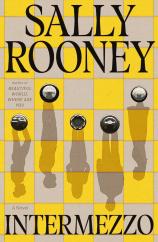Reading Group Guide
Discussion Questions
Intermezzo

1. Chess runs throughout the book as a set piece and a metaphor. What role does it serve? Why might Sally Rooney have chosen to use it?
2. In Chapter 7, Ivan reflects on Peter's seemingly effortless ability to be "a person of good sense" in social situations. In other chapters, we're privy to Peter's own internal doubts and frustrations. Why does Ivan think this, and how is it indicative of the way each brother thinks of the other? In what ways are their impressions incorrect?
3. Margaret and Ivan have a simple intimacy from the moment they meet: "I guess you only make good moves," Margaret says. "I don't make horrible mistakes," Ivan answers, to which Margaret replies, "I do." In what ways do they and the other characters make "mistakes," going against their own rules or principles, or society's? Is there an overarching moral system for Rooney's characters, or do they each follow their own compass?
4. In one of Rooney's previous novels, CONVERSATIONS WITH FRIENDS, Frances writes to her friend, Bobbi, "To love someone under capitalism you have to love everyone." Does INTERMEZZO take a similar stance? How are the characters' lives controlled or contained by their socioeconomic positions?
5. An intermezzo is a short independent piece that plays in between the acts of a play or opera. Why do you think Rooney used this word for the title, and how does this concept function in the novel?
6. Desire --- sexual, emotional, intellectual --- is often presented as an alternative to societal convention. Margaret recalls having once felt "contained before, contained and directed, by the trappings of ordinary life." How does the novel portray human interaction, romance and love as informed by, and in spite of, external factors?
7. "Quietly they look at one another. Love at times indistinguishable from hatred. What they represent to one another: unsatisfiable desires." Here, Peter and Sylvia --- and in other moments, Ivan and Peter --- contain both love and hatred for each other. In what ways is love at times indistinguishable from hate? How does Rooney show us this?
8. Consider how the chapters are narrated. For example, Peter's chapters have a marked use of fragments, capturing thought on the move. Other characters express themselves in different registers. What is the significance of Rooney's stylistic choices? What effect is achieved?
9. When they go for coffee together, Sylvia asks Ivan to talk her through a perplexing logic puzzle about a liar who claims that all his hats are green. Later, Peter likens himself to a "false true lover." What are the characters' relationships to truth and lies?
10. “Why anyway attachment, why always this attachment to particular people,” Peter wonders, thinking about Sylvia, Naomi and himself. "Attachment, the cause of all suffering." In another moment, Margaret thinks of life as netting: "There is no such life, slipping free: life is itself the netting, holding people in place, making sense of things." What are the characters attached to, and how do these attachments affect them and their relationships?
11. Toward the end of the novel, Peter ponders Wittgenstein's famous paradox --- that the presence of two options only gives us a picture, a frame --- and considers what the "third possibility" means. In what ways does the novel present an idea of a “third possibility"? How does the novel pose alternative ways of being and living with one another?
12. Where and how do you see grief and loss manifesting in the novel --- in Peter's and Ivan's lives and beyond? How do their relationships to these concepts evolve?
13. How did your reading experience of INTERMEZZO compare with that of Rooney's previous novels? In what ways does this work feel true to her sensibility, and in what ways does she accomplish something different?
Intermezzo
- Publication Date: September 24, 2024
- Genres: Fiction
- Hardcover: 464 pages
- Publisher: Farrar, Straus and Giroux
- ISBN-10: 0374602638
- ISBN-13: 9780374602635







